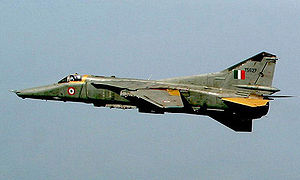Mig 27
| MiG-27 | |
|---|---|
 |
|
| A MiG-27 of the Indian Air Force | |
| Role | Ground-attack aircraft |
| National origin | Soviet Union |
| Manufacturer | Mikoyan-Gurevich / Mikoyan |
| First flight | 20 August 1970 |
| Introduction | 1975 |
| Status | In service |
| Primary users |
Soviet Air Forces (historical) Russian Air Force Indian Air Force |
| Produced | 1970–86 |
| Number built | 1,075 including licensed production |
| Developed from | Mikoyan-Gurevich MiG-23 |
The Mikoyan MiG-27 (Russian: Микоян МиГ-27; NATO reporting name: Flogger-D/J) is a variable-geometry ground-attack aircraft, originally built by the Mikoyan-Gurevich design bureau in the Soviet Union and later license-produced in India by Hindustan Aeronautics as the Bahadur ("Valiant"). It is based on the Mikoyan-Gurevich MiG-23 fighter aircraft, but optimized for air-to-ground attack. Unlike the MiG-23, the MiG-27 did not see widespread use outside Russia, as most countries opted for the Mikoyan-Gurevich MiG-23BN and Sukhoi Su-22 instead. It remains in service with the Indian, Kazakh and Sri Lankan Air Forces in the ground attack role. All Russian and Ukrainian MiG-27s have been retired.
The MiG-27 shares the basic airframe of the MiG-23, but with a revised nose – nicknamed "Utkonos" ("Platypus") in Russian service, first introduced on the MiG-23B. Dissatisfaction with the MiG-23BN led to the further development of the basic airframe to accommodate a stronger undercarriage, simpler intakes and a shorter exhaust nozzle, without radar in favor of a downward-sloping profile for improved pilot visibility, a laser rangefinder and marked-target seeker. Among its test pilots, it was also called "Balkon" ("Balcony") because of the increased frontal view from the cockpit. Additional cockpit armor was installed, along with a totally new nav/attack system.
Since the MiG-27 was intended to fly most of its missions at low altitude, the MiG-23's variable intake ramps and exhaust nozzles were discarded in favor of a simpler fixed configuration, reducing weight and maintenance requirements. The aircraft also has larger, heavy-duty landing gear to facilitate operation from poorer-quality airfields. In accordance with the MiG-27s strike and low-level attack requirements, provisions were made to mount missiles and precision-guided munitions, as well as retaining a nuclear capability in line with other Soviet combat aircraft by introducing specialized navigation systems.
...
Wikipedia
